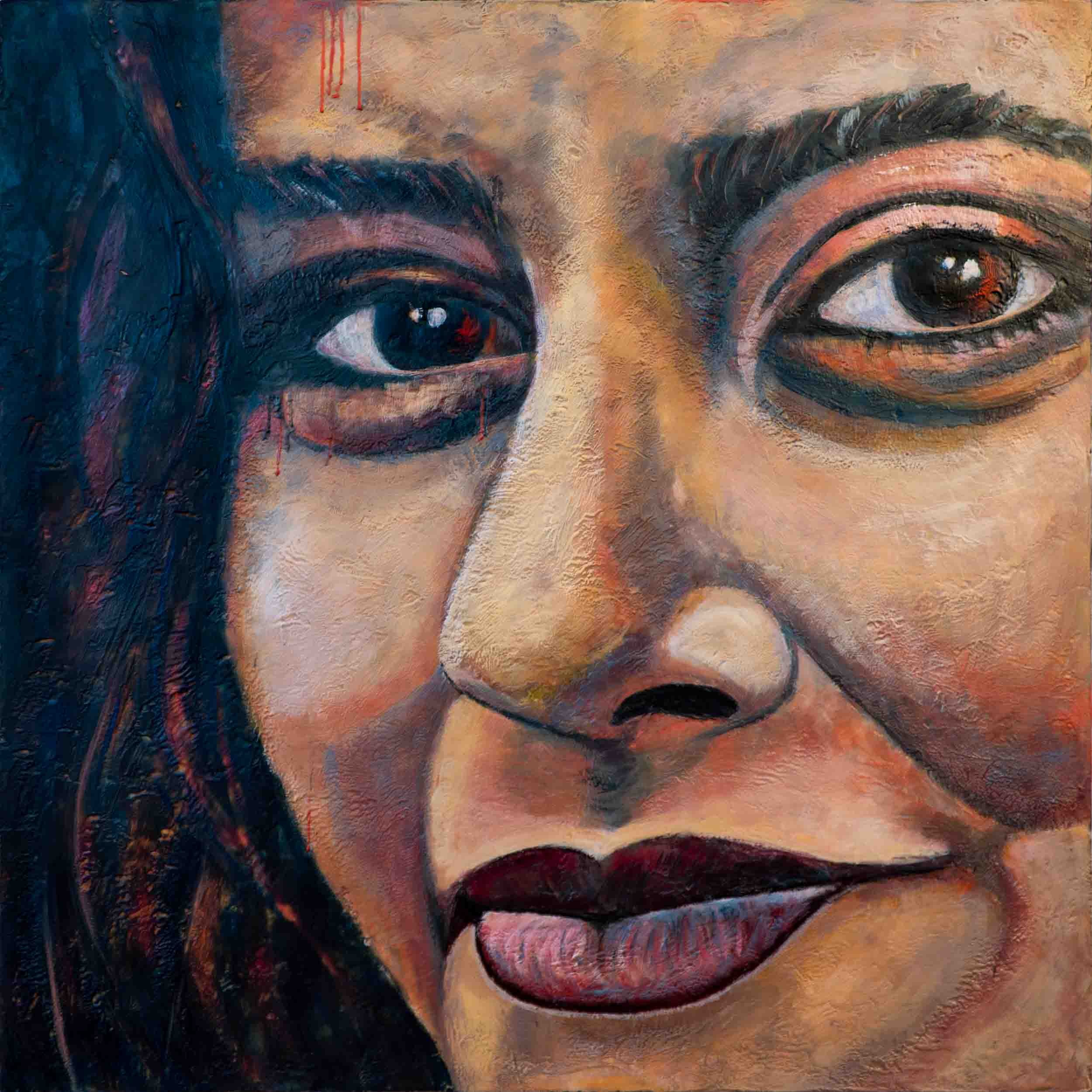Loosely Lucretia
impression of Mahsa Amini
Mahsa Amini is the 22-year old woman whose death at the hands of the religious morality police has sparked an on-going revolution in Iran.
Mahsa Amini was arrested for allegedly not wearing the hijab in accordance with government standards. Eyewitnesses reported that she was severely beaten and died as a result of police brutality. The Iranian authorities denied this assertion and went to great lengths to invent other reasons for her death.
Her death resulted in a series of widespread protests in which female demonstrators have publicly cut their hair and removed their hijab as acts of protest.
Mahsa Amini was a healthy, quiet and shy young woman who avoided politics and hoped to become a lawyer. She had come to Tehran to visit her brother and was arrested by the Guidance Patrol while in the company of her family.
Protests began hours after her death and spread quickly to other parts of the country and across the Internet. The government has attempted to intervene with tear gas and live rounds but the protests continue.
Shortly after the Iranian Revolution of 1979, Iran introduced a mandatory dress code for women. Khomeini, the supreme leader, decreed that women would be considered “naked” without the hijab and no longer permitted to enter any government office without the hijab.
Protests against the compulsory hijab have been common since 1979. By 2010, women began to be more liberal with the rules. This gave rise to the “Guidance Patrol”, Iran’s morality police which launched campaigns to verbally admonish or violently arrest and “re-educate” women they considered to be wearing the hijab incorrectly.
By December 2022 at least 476 people had been killed by security forces attacking protests across the country.
A newspaper with a cover picture of Mahsa Amini, a woman who died after being arrested by the Islamic republic's "morality police" is seen in Tehran, Iran September 18, 2022. Majid Asgaripour/WANA (West Asia News Agency) via REUTERS
“The power of Amini’s death, however—and the reason for her inclusion on the Forbes list of the World’s 100 Most Powerful Women—is that what started as an outcry against the regime’s treatment of women has evolved into a revolutionary movement calling for regime change, recognized throughout the world. Amini’s name has not only become synonymous with the theocratic government’s repression of its citizens, it’s also transformed into a hashtag that, as of November 30, had been used 79 million times.”
Women hold up signs with the image of 22-year-old Mahsa Amini, who died while in the custody of Iranian authorities, during a demonstration denouncing her death outside the UN offices in Arbil, the capital of Iraq's autonomous Kurdistan region, on September 24.SAFIN HAMED/AFP/GETTY IMAGES
“Mahsa Amini is now a global symbol for freedom, not just in Iran.”
A protest in Berlin against the Iranian regime's crackdown and policy of executing protesters on Dec. 13, 2022. (Credit: John Macdougall/AFP)
“This is not a protest anymore, this is a revolution, in Iran. And the people of the world have to see it.”
“We’re seeing the [young] women of Iran taking charge, they are galvanizing the entire country, and the men are with them.”
lucretia
Lucretia was an ancient Roman noblewoman who was blackmailed and raped by a guest to her home - the king’s son, Sextus Tarquinius (Tarquin).
The next morning, Lucretia tells her story to her father, the chief magistrate of Rome, and to her husband.
Despairing of the time the men are debating what to do, Lucretia cries out for vengeance, stabs herself in the heart and dies.
Her rape and subsequent suicide so enraged the public that this triggered a revolution which precipitated the fall of the Roman monarchy and led to the formation of the Republic of Rome.
The Death of Lucretia, Ludovico Mazzanti, c. 1730, Los Angeles County Museum of Art
Tarquin and Lucretia, Tintoretto, Art Gallery of Chicago
This painting by Tintoretto was the catalyst for my project Eyeing Medusa.
Looking at the blank face of Lucretia in this work reminded me of my own reaction when I too was violated by a trusted guest to my home. I recalled asking my doctor why I didn’t fight back sufficiently, and she replied: “most don’t”. Her answer stayed with me until the moment that I began to study this artwork.
I had recently returned from Italy where I had seen a number of powerful artworks depicting women in various stages of violation and abuse. Both Bernini’s sculpture The Rape of Persephone and Hironymous Bosch’s Liberata Triptych had profoundly touched me and left me thinking: “This demands a response.” However, it was viewers’ reactions to the works that horrified me as much as the artworks themselves. For viewers today, seeing a women objectified, victimized, violated, raped or blamed has become completely normal.
As I was studying Tintoretto’s work Tarquin and Lucretia, I found myself feeling nauseous and weary of the same stories being enacted and depicted again and again.
In a flash I realized that we need to change the way we see and relate to women.
I realized that I needed to present women in an entirely different light, not as hyper-sexualized victims, but as valiant, resilient and powerful individuals. And, by focusing on their faces, I could avoid everything traditionally used to objectify women and inspire viewers to look into the eyes and come to understand who she is and why she matters.
This, for me, was the start of Eyeing Medusa.
The death of Mahsa Amini has touched the lives of women and men around the world. From being a victim of hard-right traditional perceptions manifesting themselves in the Morality Police, she has become a symbol of change, honour, resistance and strength.
Mahsa Amini’s death has awoken the world to the fact that it is indeed time to change the way we see and relate to women.
Loosely Lucretia — Impressions of Mahsa Amini, Amanta Scott, encaustic on canvas on birch panel, 96.5 x 96.5 cm
References
- https://en.wikipedia.org/wiki/Death_of_Mahsa_Amini
- https://www.reuters.com/world/middle-east/frances-ministry-foreign-affairs-condemns-death-mahsa-amini-2022-09-19/
- https://www.womensvoicesnow.org/irans-women-revolution New Larousse Encyclopedia of Mythology*, Hamlyn Publishing Group Ltd., New York, 1959
- Ancient Mirrors of Womanhood, Merlin Stone, Beacon Press, Boston, 1984
- Dictionary of Greek and Roman Biography and Mythology
- When God Was A Woman, Merlin Stone, Harvest Edition, 1976
- The Civilization of the Goddess, The World of Old Europe, Marija Gimbutas, HarperCollins Publishers, 1991
- The Language of the Goddess, Marija Gimbutas, HarperRow publishers, San Francisco, 1989






